new posts in all blogs
Viewing: Blog Posts Tagged with: Elementary school, Most Recent at Top [Help]
Results 26 - 50 of 102
How to use this Page
You are viewing the most recent posts tagged with the words: Elementary school in the JacketFlap blog reader. What is a tag? Think of a tag as a keyword or category label. Tags can both help you find posts on JacketFlap.com as well as provide an easy way for you to "remember" and classify posts for later recall. Try adding a tag yourself by clicking "Add a tag" below a post's header. Scroll down through the list of Recent Posts in the left column and click on a post title that sounds interesting. You can view all posts from a specific blog by clicking the Blog name in the right column, or you can click a 'More Posts from this Blog' link in any individual post.
By: johnmanders,
on 3/12/2014
Blog:
John Manders' Blog
(
Login to Add to MyJacketFlap)
JacketFlap tags:
author,
illustrator,
literacy,
education,
self promotion,
elementary school,
school visit,
PTA,
PTO,
School librarian,
Add a tag
I am booking school visits in the Pittsburgh, Pennsylvania area for Read Across America Week, March 2 – 6, 2015. Friday the 6th just got reserved this morning. If I can book the whole week, everybody gets me for 25% off the regular rate.
Contact Lisa— [email protected]


Watch a video call I had with elementary school students from Julie Johnson's school about the upcoming Classroom Slice of Life Story Challenge. 
Ralph Tells a Story written and illustrated by Abby Hanlon (Amazon Children’s Publishing, 2012). It doesn’t matter if your five or twenty-five—if you’re in school, you’re gonna have to write. And lots of times you have to write stories—stories about yourself. Maybe it’s a daily journal. Maybe it’s a “My Special Moment” essay. Maybe it’s a descriptive narrative for a college composition class. Well, if you’re one of those kids who has NO IDEA what to write about and can’t think of ONE SINGLE STORY, then Abby Hanlon’s Ralph Tells a Story is the book for you. Ralph’s teacher always says, “Stories are everywhere!” and the kids in Ralph’s class have no trouble finding them. They write pages and pages and pages during writing time. But Ralph can’t come up with anything. Zero, zip, nada. So Ralph does what all smart kids do. He stalls. He goes to the bathroom. He gets a drink. He offers to help the lunch ladies. And finally, finally, Ralph thinks of the start of a story. But then he gets stuck. Which is exactly when his teacher asks him to share his story. Luckily for Ralph, his classmates ask lots and lots of questions. [...]
By:
KidLitReviews,
on 7/18/2012
Blog:
Kid Lit Reviews
(
Login to Add to MyJacketFlap)
JacketFlap tags:
dragons,
elementary school,
classroom,
hippopotamus,
5stars,
Library Donated Books,
Chasing Watermelons,
condors,
great illustrations,
harries teachers,
mastadons,
pygmies,
teachers,
sharks,
pirates,
Children's Books,
picture book,
dogs,
Favorites,
Add a tag
5 Stars Back Cover: When Stubby Pencil Noodlehead is forced to stand in front of his class to explain why he is late for school every day, the resulting tale is more than the teacher bargained for. Stubby’s story of pirates, pygmies, mastodons, and more, turns classroom order to chaos, and has yhe teacher begging [...]

By:
Claudette Young,
on 2/19/2012
Blog:
Claudsy's Blog
(
Login to Add to MyJacketFlap)
JacketFlap tags:
tradition,
London,
Olympic Games,
Olympic Flame,
Life,
family,
Hollywood,
Elementary school,
Writing and Poetry,
Questions to Ponder,
Today's Questions,
Fanily Connections,
2012 Summer Olympics,
Add a tag
The Olympics have torch bearers who run through the streets, flaming torch held high, expressing sublime joy or intense nobility as they run. Marathon participants run for a variety of reasons, many of which express that same joy or nobility. Ordinary family members don’t do much running at all, unless one counts errands and an extracurricular shuttle service.
Throughout my growing up years, carrying a torch meant something other than its current connotation. We carried a torch for a movie star or the girl/boy at school. We carried the torch of freedom in our citizenship and moral fiber. It’s a wonder the town didn’t burn to the ground with all of those flames being held up for all to see.
Few of us got to see an Olympic torch during the fifties. Even our own Student Olympics during elementary school didn’t have a torch. Television brought the Olympic Games to average households every four years during the sixties, which is where I first saw them. Of course, the opening ceremonies, with torch-bearer and Olympic Flame weren’t as long or elaborate then as they are now. Drama and spectacle arrived during the early eighties. Leave it to Hollywood.
All of this brings us to carrying the family torch. Each family has an invisible one, though the flames may be for different purposes. For some that torch stands for pride of place within society. For others it represents the family triumph over poverty and disadvantage. Torches for those prideful of family traditions of church, home, and military honor cut across all strata of society. These are all family torches; the ones that children take from their parents, along the line of ancestral heritage.
Torches smolder at times. They can exhibit rebellion over family roots as much as the opposite. They can glow with remembered suffering from a historical past before bursting into raging flame. While each is sparked by one or more family aspect, only an individual can carry one and that for personal reasons.
People can find a family torch inside themselves, if they look for it. They can discover the personal reason for raising an arm to support that tapered torch. At some point, they must either acknowledge acceptance of “duty” or reject it and seek another.
Each of us has a choice as to which torch we carry for our family. Considering how broad the definition has become for “family,” we should marvel at how many torches one person can juggle at any given time. The reasons and purposes of torches have broadened as well.
At the end of the day, the person needs to ask herself, “Which torch did I choose today?” and “Should I choose to bear that flaming burden tomorrow?”


 0 Comments on Carrying the Family Torch as of 1/1/1900
0 Comments on Carrying the Family Torch as of 1/1/1900

By:
Claudette Young,
on 2/19/2012
Blog:
Claudsy's Blog
(
Login to Add to MyJacketFlap)
JacketFlap tags:
Life,
family,
Hollywood,
tradition,
London,
Elementary school,
Writing and Poetry,
Olympic Games,
Olympic Flame,
Questions to Ponder,
Today's Questions,
Fanily Connections,
2012 Summer Olympics,
Add a tag
The Olympics have torch bearers who run through the streets, flaming torch held high, expressing sublime joy or intense nobility as they run. Marathon participants run for a variety of reasons, many of which express that same joy or nobility. Ordinary family members don’t do much running at all, unless one counts errands and an extracurricular shuttle service.
Throughout my growing up years, carrying a torch meant something other than its current connotation. We carried a torch for a movie star or the girl/boy at school. We carried the torch of freedom in our citizenship and moral fiber. It’s a wonder the town didn’t burn to the ground with all of those flames being held up for all to see.
Few of us got to see an Olympic torch during the fifties. Even our own Student Olympics during elementary school didn’t have a torch. Television brought the Olympic Games to average households every four years during the sixties, which is where I first saw them. Of course, the opening ceremonies, with torch-bearer and Olympic Flame weren’t as long or elaborate then as they are now. Drama and spectacle arrived during the early eighties. Leave it to Hollywood.
All of this brings us to carrying the family torch. Each family has an invisible one, though the flames may be for different purposes. For some that torch stands for pride of place within society. For others it represents the family triumph over poverty and disadvantage. Torches for those prideful of family traditions of church, home, and military honor cut across all strata of society. These are all family torches; the ones that children take from their parents, along the line of ancestral heritage.
Torches smolder at times. They can exhibit rebellion over family roots as much as the opposite. They can glow with remembered suffering from a historical past before bursting into raging flame. While each is sparked by one or more family aspect, only an individual can carry one and that for personal reasons.
People can find a family torch inside themselves, if they look for it. They can discover the personal reason for raising an arm to support that tapered torch. At some point, they must either acknowledge acceptance of “duty” or reject it and seek another.
Each of us has a choice as to which torch we carry for our family. Considering how broad the definition has become for “family,” we should marvel at how many torches one person can juggle at any given time. The reasons and purposes of torches have broadened as well.
At the end of the day, the person needs to ask herself, “Which torch did I choose today?” and “Should I choose to bear that flaming burden tomorrow?”


 2 Comments on Carrying the Family Torch, last added: 2/20/2012
2 Comments on Carrying the Family Torch, last added: 2/20/2012
The
Cybils award was announced yesterday. Hooray! For the Love of Books! I love the Cybils because they are chosen by book-lovers around the world. I've been a judge several times. I missed it this year, since I was busy baby-growing (and my hubby is a little overwhelmed by the number of books around here...)
Anyway, don't miss the
shortlists, either. Out of hundreds of books, each group of judges picks their top few for these shortlists. Then a different panel of judges chooses one top selection.
You can see my review of the fiction picture book winner, Me...Jane,
right here. You know, I really
heart picture books.
Loves.

By: shelf-employed,
on 8/4/2011
Blog:
Shelf-employed
(
Login to Add to MyJacketFlap)
JacketFlap tags:
rhyming,
confidence,
book review,
elementary school,
cookies,
fractured folktales,
funny,
E,
school,
Add a tag

Many school-related picture books have arrived on my desk in the last week or two, but these are the only two I've really liked.
David Milgrim has a real flair for simplicity. I've never reviewed them, but his Ready-to-Read books featuring Pip and Otto are my favorites for very early readers.
Eddie Gets Ready for School is not an easy reader, but it's masterful in its simplicity. It's nothing more than a checked-off list, one or two items per page, of all the things Eddie "needs" to do before school,
Put cat in backpack
Hug Mom
Take cat out of backpack
Find something else for show & tell
Some items (Eddie choosing in turn, the dog, goldfish, bird, and flat screen TV for show & tell), don't make the written list and are expressed only in the crisply drawn cartoon images on white space. Mom and the dog are featured throughout the story. Mom is happy and supportive, although root beer and cartoons for breakfast
does try her patience a bit. So what
does Eddie finally choose for a snack and show & tell? You'll never guess! This is a
very funny back-to-school gem!
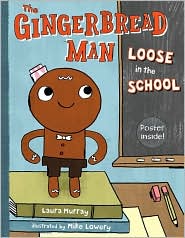 Murray, Laura. 2011. The Gingerbread Man Loose in the School. Ill. by Mike Lowery. New York: Putnam.
Murray, Laura. 2011. The Gingerbread Man Loose in the School. Ill. by Mike Lowery. New York: Putnam.This gingerbread man is not running away as fast he can; he's running to catch up! The children have cooked him up at school but, oh no! He's left behind when it's time for recess, but he's a smart cookie. He'll find them,
I'll run and I'll run,
as fast as I can.
I can catch them! I'm their
Gingerbread Man!
Along the way, he loses a toe,
I'll limp and I'll limp,
as fast as I can. ...
and almost ends up as someone's snack,
I plopped on a sandwich
and chips with a crunch
OH NO! I cried out.
I'm in somebody's lunch!
The story is told entirely in rhyme and presented comic style with panels and word bubbles. Cute and simple. Kids will eat this one up.
Librarians will want to remove the poster before circulating this one. Teachers will want to hang it in the classroom.Author Laura Murray's website has some great Gingerbread Man extras - and a RT script coming soon!
Life has been full! Here are some pics to prove it!
Arkansas Literary Festival

April 8, Literacy on the Lawn, Governor's Mansion
School Visits: Paris Elementary and Cherry Valley Elementary
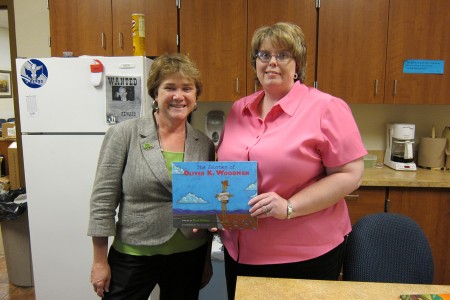
Teressa, Cherry Valley Elementary Literacy Coach
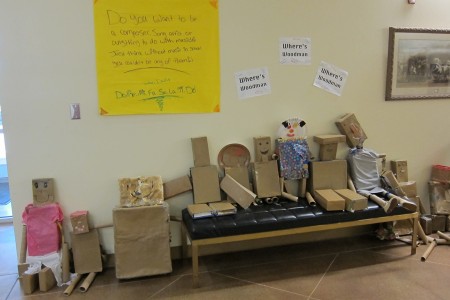
Oliver K. Woodman Project by Cherry Valley Elementary Students
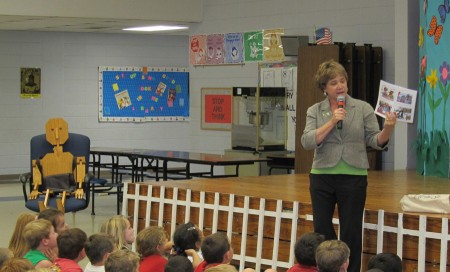
Paris Elementary Assembly: Reading The Scary Slopes.
After School Quilts
I wish I could show you the kids who made these quilts (privacy issues!). They had a blast. There were five boys and one girl and everyone had a great time. We talked about the history of quilting and they chose to make Amish quilts; I think they liked the black, as much as anything. We met once a week for about 8 weeks to finish these projects.
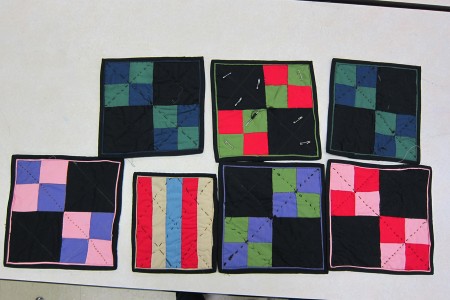
Amish Quilts made by 10 year olds.
 NonFiction BookBlast
Sunday, June 26, 2011. 8-10 am.
ALA Conference in NOLA.
NonFiction BookBlast
Sunday, June 26, 2011. 8-10 am.
ALA Conference in NOLA.

I received some new picture books for review, and I'm excited to tell you about three that are super fun. There's a picture book, a board book, and a book that falls somewhere in between. :)

 Press Here
Press Here by Herve Tullet
by Herve Tullet
I love when a picture book interacts with young readers in a unique, creative way. This book definitely does that.
Young readers follow simple instructions on each page. Their actions result in changes in the dots. For example, it says to tap five times on the yellow dot, and then when you turn the page, five dots are there. When you shake the book to one side, all the dots fall that direction. When you blow the book, the dark background creeps away.
Press Here would be great for preschoolers and new readers who can manage words like 'finally' and 'straight'.
The pages of the book are sturdy, somewhere in between a board book and a normal picture book.
Along with a whole lot of fun, this book is great for young children learning to follow directions.

 Me...Jane
Me...Jane by Patrick McDonnell
by Patrick McDonnell
Jane Goodall is well-known for her work with animals, particularly chimpanzees...but what was she like as a child? In Me...Jane, you'll find simple text, enchanting artwork, and a small girl who loves her stuffed chimp, Jubilee.
Jane always loved nature. As she explored and studied books about nature, she had Jubilee to keep her company. He even came along when Jane hid in Grandma Nutt's chicken coop to find out where eggs came from.
This book is full of the wonder of childhood. The story doesn't give much information about Jane herself, but it shows her ever-growing love for the world around her and shows how she lived her dreams.
The end of the book has a biography about Jane Goodall and a note
Even the youngest of students can learn some basics about fractions with this mini lesson.
Orange Fractions
1. Peel an orange and separate it into two halves. Discuss how there are two parts of one whole orange, thus two halves make one whole.
2. Split the orange into four parts and discuss.
3. Separate all the orange pieces. Ours had twelve parts. Hold three pieces in your hand and ask, "How many parts do I have?" 3. "Out of how many?" 12. "3 parts out of twelve parts is 3/12." If kids are grasping the concept well, explain that 3/12 is the same as 1/4 of the orange.
Liquid Fractions1. Fill a 1 C measuring cup with water or beans. If using water, you may want to put a cookie sheet underneath.
2. Allow kids to experiment with various measuring cups. Help them reach the discovery that 4 1/4 cups make 1 C and 3 1/3 cups make 1 C.
3. Explain why it works that way. Because 3 parts out of 3 make a whole, etc.
By: 1questionaday,
on 3/26/2011
Blog:
One Question A Day
(
Login to Add to MyJacketFlap)
JacketFlap tags:
writing,
middle school,
Spring,
elementary school,
Childhood,
questions,
secret,
The Great Outdoors,
hideout,
Add a tag
I can't wait for Spring! You know how Target has that section where everything costs a buck or two? Well, this week, we found some mini tomatoes and bell peppers in little pots. I'm so excited to see bits of green pop through the soil in my kitchen.
In honor of the approaching season, here are one-word reviews of our favorite spring-ish picture books...

 Muncha! Muncha! Muncha!
Muncha! Muncha! Muncha! by Candace Fleming: Gardenlicious!
by Candace Fleming: Gardenlicious!
Each morning after breakfast, we do a Mini Lesson, which is a short lesson about whatever random thing I think of. Sometimes the ideas are inspired by the kids and sometimes not.
Mini Lessons are a great way to introduce ideas and concepts that don't already fit into our daily work...and they're pretty much the kids' favorite part of the day. I never tell them ahead of time what it will be. The surprise helps keep them fun.
Here are some of the lessons we've done...
1. Tell a short story that includes basic shapes. Trace the shapes in the air while you tell it, and then have everyone draw an interpretation of the story. After you've set the example, have the kids tell a brief story and have everyone draw theirs, too.
2. Compare a flat world map with a globe. Find where you live on both. Identify the 7 continents. Color and label the continents on a blank world map.
3. Measure things around the house with a measuring tape/ruler. Record findings. (When we did this, we discovered that Y's neck is bigger around than his big sister's and brother's necks! No wonder we can't button the top button of his church shirt!)
4.
Make coin critters! We absolutely love this idea from Family Fun.
5. Make paper airplanes. Talk about lift and gravity. Color and label a diagram of a wing.
6. Build card houses. (This one turned into a zoo for little stuffed animals.)
7. ABC Gratitudes. Write out the letters A-Z, one letter on each line. The first person fills in something that they're grateful for that starts with an A, then passes it to the next person, until you have a whole alphabet of thanksgiving.
8. Work on memorizing the 50 States Song.
Right after Mini Lesson, I read aloud to the kids, so I like to finish with something they can do with their hands while I read...usually it's some kind of coloring. They also like to embroider, finger knit, draw, and write notes while I read.
I keep a running list of ideas that is easily accessible because some days I have lots of ideas and other days I don't.

 The Quest of the Warrior Sheep
The Quest of the Warrior Sheep by Christine and Christopher Russell
by Christine and Christopher Russell
When 5 Rare Breed sheep find a cell phone that fell from the sky, they think it is a call to fulfill an ancient prophecy. They embark on a great adventure, which takes them on a subway, a train, a helicopter, a tractor, and finally up into a vicious mountain storm.
The boy who lives next door to the sheep believes they've been abducted by aliens.
The cell phone they found is actually important evidence in a bank heist, which resulted in the sheep's owners losing all of their life savings.
It's quite an adventure. We finished reading it this morning, and both Bubs and Welly have separately already asked me to start reading it again.
The five sheep are great, unique characters. There's Sal. She's kind of the leader, although not necessarily the smartest. There's Oxo, who really only cares about eating. There's Links, who is always breaking out into a rap. There's Jaycey, who is dainty and cares about her hoof paint. And lastly, there's Wills. He's the real brains of the group.
On the Con side, this book has some not-so-nice for little kids language. Since I was reading it aloud, it wasn't a problem, but there are quite a few stupids, shut-ups, and some name-calling (geek and Woolbags mostly) that I skipped over. There is also one scene where the neighbor boy takes a reporter out for dinner and Beer. I just said drink instead of Beer. Anyway. Fair warning.
For the reasons mentioned above, I recommend reading it aloud to your kids. My 7 and 5 year old seemed about the perfect ages for it. Amazon recommends it for 9-12, so that too, I guess. :)
Scheduling1. Call the venue where you want to go in advance. Some places require a lot of notice, and some aren't ready far in advance. Your best bet is to call a month or more before, and then if they don't plan that far out, you call again as the desired date approaches. Be open to their schedule if possible. Be prepared with an estimate of the number of participants. Ask about group rates/field trip rates.
2. Give everyone a calendar of scheduled events, and then remind them as the field trip approaches. On the schedule, be sure to include the name of the venue, the address, the date and time, the price, and any other important info. Also include your contact info in case they get lost or need to cancel.
3. When my kids were little, I led a playgroup. Every other week was a field trip, while the alternating weeks were park days/play dates in homes. It was a great experience, but the field trip costs added up. I tried to incorporate as many free activities as possible, such as nature walks.
Now I organize a monthly field trip for our homeschool co-op. Once a month feels like a better amount for my family at this time.
Collecting Money
Some venues require that everyone pay as a group. This can be the hardest part of planning an event. If you have to pay together, have everyone mail you or hand you their money in advance. Keep a list of everyone you are expecting, and check off their names as you receive their money. I also like to keep a tally of the total number of people for ease of paying. If the price is different for adults and children, keep separate tallies for them. You may want to require that everyone pay you in cash so you can include it when you pay for the group.
 Discuss Respect
Discuss Respect
Sometimes it is necessary to briefly talk to the kids about how they should behave while on the field trip. On a recent visit to the police station, it was necessary to be very quiet, so we wouldn't disturb the dispatchers. Talk about showing respect for your guides and following their rules.
Have Fun
Stay together. Have plenty of adults. It helps if the adults are engaged in the field trip, as well. Their interest will rub off on the kids.
Does anyone else have tips for planning field trips for large groups?

Grounded by Kate Klise
Check out my review at Waking Brain Cells, the new home of this blog. I will stop posting here at Kids Lit at the end of the week.

The Secret River by Marjorie Kinnan Rawlings, illustrated by Leo and Diane Dillon
Check out my review on Waking Brain Cells.

Family Pack by Sandra Markle, illustrated by Alan Marks
Check out my review on Waking Brain Cells.

Zita the Spacegirl by Ben Hatke
This is a great graphic novel for elementary readers who will enjoy the action and the science fiction setting. Zita and her friend Joseph see a meteoroid fall to earth. When Zita looks closely, she sees that there is something embedded in the meteoroid. It looks like a red button and despite her friend’s protests, she presses it. Immediately, a rift opens and sucks Joseph through it. After some moments of panic, Zita presses the button again and heads through the rift to rescue her friend. On the other side of the rift, Joseph is being dragged away by a strange multi-armed alien who flies off with him in a space ship. Now Zita is left alone in a strange world filled with amazing creatures. Unfortunately, it’s a world about to be destroyed by a giant asteroid. How is Zita going to be able to save her friend before the planet is demolished?
Hatke is a great storyteller. Zita is a friendly, determined and strong girl character, who remains solidly the heroine of her story. Through his friendly illustrations Hatke has created a world that makes one feel at home despite its strangeness. The adventure here is thrilling, dangerous and great fun. As Zita adventures through the world, readers will enjoy the humor of different characters. Hatke embraces nuanced characters as well, which is a treat in a graphic novel for children.
The illustrations here have an anime appeal to them. Young fans of Pokemon will feel right at home with the variety of creatures that Zita meets.
This is one of those great graphic novels that belongs in every library collection. Sure to check out and be very popular, just face this one out and watch it check out of the library. Appropriate for ages 8-12.
To get a sense of the illustrations, you can view the video below:
Zita the Spacegirl Trailer
Reviewed from copy received from First Second.
Also reviewed by:
The Literate Mother
Little Lamb Books
Perpetual Learner

I Feel Better with a Frog in My Throat: History’s Strangest Cures by Carlyn Beccia
Have a symptom? Look it up in this book, but beware! Some of the cures listed just may not work. It’s up to you to try to guess which ones would actually help and which might really hurt. What would help a cough? Caterpillar fungus used in ancient China? Frog soup used in 16th century England? Cherry bark used by ancient Native Americans? Readers turn the page to discover which of the three would help. The reasons behind the use of the cure and then the real results are offered, giving a readers a fascinating tour through medical history. Happily, some of the cures are gross. That and the way the information is presented as a guessing game make this book appealing to children, including reluctant readers.
Beccia has taken a cheerful approach to what could have been a very dark book. Instead the tone stays rather merry, talking about the nutritional boost of frog soup, the healing power of spider webs, and much more. Her illustrations add to the fun with images like maggots with smiling faces and stinky socks tied around the neck. They have an interesting blend of macabre and silly.
There are some misses in the book. At one point, a woman of the 19th century is shown in a short skirt, looking very modern except for her cap. The book maintains a great pace and tone, but falls short at the end where the healing power of mother’s kisses takes on an overly sweet tone. I also have concerns about the imagery of the mothers and children, because the only one with darker skin is prehistoric. The only Asian faces are ancient. It is a frustrating misstep in a book that is good overall.
Get this into the hands of reluctant readers who enjoy gross things and you too will get to talk about maggots at the dinner table! Appropriate for ages 7-9.
Reviewed from library copy.

Guyku: A Year of Haiku for Boys by Bob Raczka, illustrated by Peter H. Reynolds
A brilliant combination of haiku poems, clever humor, and engaging illustrations, this book is sure to appeal to its target audience of guys and also to girls. Celebrating the small things in life, each haiku takes a moment in time and then offers a grin to the reader. The poems are arranged in seasons, fitting because so many of them are about nature and a boy’s relationship with it. Whether it is flying a kite, skipping rocks, leaf piles or snowball fights, children will relate easily to these vignettes about the things that make life fun.
Raczka’s haiku are light-hearted and enjoyable. Thanks to the brief nature of the format, the poems are easily shared aloud. Nicely, the poems stand on their own or work together as a larger piece of writing. Reynolds’ art is equally engaging. It too has a great humor about it but also a sense that a moment is being captured.
A celebration of seasons, play and boyhood, this book is a treat. If librarians are looking for something to take with them for summer reading program visits, the summer haiku here would make a great thing to share with boys of many ages. Appropriate for ages 6-9.
Reviewed from library copy.

Lulu and the Brontosaurus by Judith Viorst, illustrated by Lane Smith
Lulu was a pain, a real pain. She demanded that her parents give her everything she wanted. And if they didn’t? Then she threw a fit, screaming, throwing herself on the floor and kicking her feet. Until her parents agreed to give her exactly what she wanted. But that all changed when Lulu demanded a brontosaurus for a pet for her birthday. Her parents tried to explain that a brontosaurus was huge and wild and not suitable, but Lulu threw a tantrum. However, this time it did not work. So Lulu set off on her own to find herself a brontosaurus. As she entered the forest, she sang herself a song about getting a brontosaurus for a pet. Going deeper into the forest, she encountered some wild animals but even they could not scare her from her mission. Eventually, Lulu does find a brontosaurus deep in the forest, but will he be the ideal pet she has been expecting?
A great beginning chapter book, young readers will enjoy the over-the-top humor that will keep them laughing. The short chapters will also help keep reluctant readers going as will the large number of black-and-white illustrations from the master Lane Smith. The illustrations hearken back to Syd Hoff’s Danny and the Dinosaur with the smiling brontosaurus, but are edgier as well with great perspectives.
Viorst has obviously had fun playing with the book format here. She opens the book saying that of course she knows that humans and dinosaurs have never existed at the same time! It sets the tone perfectly for the story itself which is filled with humor throughout. Various fonts are used throughout the book, some for singing, others for effect in reading. Later in the book, the chapters are numbered by the half chapter just for fun and to laugh about the very short chapters of the book. And finally, the book ends with different endings for the reader to choose from.
A winning early chapter book, this has the dinosaur appeal combined with great illustrations and clever writing. Appropriate for ages 5-7.
Reviewed from book received from Atheneum.
View Next 25 Posts















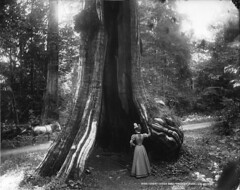
















I just passed this along to my son’s school (Propel East) to see if they’d be interested. I hope they are!!!
Thanks! Kimee
Thanks, angel!